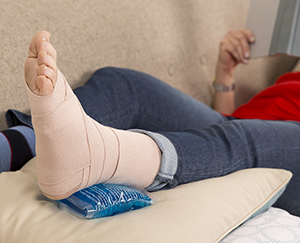PRICE
PRICE stands for protection, rest, ice, compression, and elevation. Doing these things helps limit pain and swelling after an injury. PRICE also helps injuries heal faster. Use PRICE for sprains, strains, and severe bruises or bumps. Follow the tips on this handout and begin PRICE as soon as possible after an injury.

Protection
Protection is meant to protect your injured area from more damage. It may be done by keeping the injured area immobile as much as possible with the help of a sling, splint, or brace.
Rest
Pain is your body’s way of telling you to rest an injured area. Whether you have hurt an elbow, hand, foot, or knee, limiting its use will prevent further injury and help you heal. Resting for the first 72 hours and then gradually getting back to your activities will help you recover. Stay away from any activity that causes stress to the injured area to the point of pain. Your physical therapist will prescribe a specific set of exercises to prevent loss of muscle strength in the injured area and help you recover.
Ice
Applying ice right after an injury helps prevent swelling and reduce pain. Don’t place ice directly on your skin.
-
Use a cold pack. Or make an ice pack by putting ice cubes in a plastic bag that seals at the top. Wrap the cold pack or ice pack in a thin cloth. Place it over the injured area.
-
Ice for 10 minutes every 3 hours. Don’t ice for more than 20 minutes at a time.
-
Some people are very sensitive or allergic to ice. If your skin develops an itchy rash or welts (hives) after using ice, remove the ice pack and let the area warm up. Follow up with your health care provider as soon as you can.
Compression
Putting pressure (compression) on an injury helps to reduce swelling and provides support.
-
Wrap the injured area firmly with a compression elastic bandage.
-
Apply it directly to the skin by starting a few inches below the injury.
-
Wrap it in a spiral (figure eight) to a few inches above the injured area.
-
Apply a medium amount of tension so that there is enough compression without being too tight.
-
If your hand or foot tingles, becomes discolored, or feels cold to the touch, the bandage may be too tight. Rewrap it more loosely.
-
If your bandage becomes too loose, rewrap it.
-
Don't wear an elastic bandage overnight.
Elevation
Keeping an injury elevated, or raised up, helps reduce swelling, pain, and throbbing. Elevation is most effective when the injury is raised up higher than the heart.
When to call your health care provider
Call your health care provider if you notice any of the following:
-
Your fingers or toes feel numb, tingly, are cold to the touch, or change color.
-
Your skin looks shiny or tight.
-
The pain, swelling, or bruising gets worse and isn't better with elevation.
-
You have signs of infection. These include warm skin, redness, fluid leaking, or a bad smell coming from the injured body part.
-
You can't move or bend a joint.